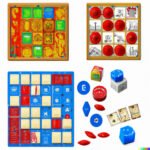Ah, the excitement of a classic murder mystery board game. Few things can match the thrill of stepping into the shoes of a detective, solving perplexing crimes from the comfort of your own living room.
In this article, we will delve into the captivating world of classic murder mystery board games, uncovering their history, sharing essential tips and strategies for winning, and exploring the evolution of this genre in both the physical and digital realms. So gather your magnifying glass and sharpen your deductive skills – it’s time to unravel mysteries like never before.
When you think of classic murder mystery board games, iconic titles such as Clue and Scotland Yard may come to mind. These timeless classics have captured the imaginations of players for decades, challenging them to think critically, analyze evidence, and unravel intricate plots. As you navigate through this article’s sections, be prepared to embark on a journey into suspense; one that will transport you back to the origins of these captivating games and shed light on their enduring appeal.
But how does one play a classic murder mystery board game? Fear not, for we will guide you through the process step by step. From understanding intricate rules to honing your detective skills, we’ll equip you with everything you need to become an expert player. Additionally, we’ll take a close look at some of the best classic murder mystery board games ever created – so get ready for a countdown that is sure to ignite your curiosity.
So join us as we explore every facet of classic murder mystery board games – from hosting memorable game nights with friends to unraveling thrilling narratives in virtual landscapes. Whether you’re a seasoned sleuth or just starting your investigation into this enthralling genre, this article is your ultimate guide. So put on your thinking cap and prepare yourself for an exciting adventure where solving crimes knows no bounds.
History of Classic Murder Mystery Board Games
As board games have been a popular pastime for centuries, it should come as no surprise that the genre of murder mystery board games has a rich and intriguing history. The origins of classic murder mystery board games can be traced back to the early 20th century, when they first gained popularity among avid gamers and mystery enthusiasts. These early games served as precursors to the thrilling murder mystery experiences we know today.
One of the earliest examples of a murder mystery board game is “Cluedo,” which was first released in 1949. Created by British musician Anthony E. Pratt, this game quickly gained a cult following for its unique blend of deduction, strategy, and suspense. The premise of “Cluedo” revolves around solving the murder of Mr. Boddy, with players assuming the roles of suspects who must gather clues to uncover the truth.
In the following decades, classic murder mystery board games continued to captivate audiences with their intriguing narratives and challenging gameplay mechanics. Titles such as “Scotland Yard,” “221b Baker Street,” and “Mystery Mansion” became staples in many households, providing hours of entertainment for players young and old. These early games laid the foundation for what would later become a flourishing genre in the world of board gaming.
The history of classic murder mystery board games is not just limited to physical tabletop experiences but has also branched out into different mediums over time. With advancements in technology and the rise of digital platforms, these games have found new life in video game adaptations and online formats. As technology continues to evolve, so does our fascination with crime-solving mysteries, ensuring that classic murder mystery board games will continue to thrive for years to come.
Unleashing the Detective Within
Playing a classic murder mystery board game is an exciting and immersive experience that allows you to unleash your inner detective. With intriguing storylines, challenging clues, and suspenseful gameplay, these games provide hours of entertainment. If you’re new to the world of murder mystery board games or want to brush up on your detective skills, this section will guide you on how to play.
Setting up the Game
Before diving into the gameplay, it’s important to set up the game properly. Each murder mystery board game comes with its own unique set of rules and components, so be sure to read the instruction manual carefully. Typically, players are assigned characters who have different roles within the game’s narrative. Distribute character cards and any additional materials required for gameplay.
Understanding the Objective
The goal of a classic murder mystery board game is usually to identify the culprit behind a fictional crime by collecting and analyzing clues. As a player, your objective is to gather as much information as possible, interact with other characters through questioning and deduction, and solve the mystery before anyone else does. Pay close attention to details presented in various forms such as cards, booklets, or a central game board.
Gameplay Mechanics
Classic murder mystery board games often involve taking turns where players can perform actions such as moving around the game board, interacting with other characters through scripted dialogues or questioning them about specific topics related to the crime. These interactions can provide valuable information or mislead you if other players are trying to throw you off track. Use reasoning skills and deductive thinking to narrow down suspects and motives based on the clues obtained throughout the game.
As you progress through the game, new information may be revealed that could change your understanding of the case. Be prepared for plot twists and unexpected outcomes which add excitement to gameplay. Communication between players is crucial as it allows for collaboration, sharing of information, and forming theories together. Work with the other characters to piece together the puzzle and solve the mystery.
Playing a classic murder mystery board game is an immersive experience that challenges your analytical thinking, deduction skills, and ability to uncover the truth. By following the setup instructions, understanding the objective, and mastering gameplay mechanics, you can fully embrace your inner detective and enjoy hours of thrilling entertainment. So gather your fellow crime solvers, prepare for suspenseful twists, and dive into the world of classic murder mystery board games.
The Best Classic Murder Mystery Board Games of All Time
Classic murder mystery board games have long been a staple in the world of tabletop gaming, providing hours of suspense and intrigue for players of all ages. Whether you are a seasoned detective or new to the genre, there are countless classic murder mystery board games that have stood the test of time and continue to captivate players today.
In this section, we will countdown some of the best classic murder mystery board games of all time, each offering its own unique twist on solving crimes.
Clue (aka Cluedo)
Undoubtedly one of the most well-known classic murder mystery board games, Clue has been entertaining players since its release in 1949. Set in a mansion, players take on the roles of suspects trying to uncover who committed the dastardly deed, which weapon was used, and where it took place.
With deductive reasoning and careful note-taking, players must navigate through hidden passages and gather clues as they try to solve the mystery before their opponents do. Clue has become a household name synonymous with murder mysteries, making it a must-have for any game night.
Scotland Yard
Transporting players to the streets of London, Scotland Yard is an iconic deduction game released in 1983. One player takes on the role of Mr. X, a criminal mastermind on the run throughout London’s transportation network.
The other players assume the roles of detectives who work together to track down Mr. X’s whereabouts by deducing his next move based on limited information provided through taxi, bus, and subway tickets. Scotland Yard challenges players’ strategic thinking and teamwork skills as they race against the clock to catch Mr. X before he escapes.
Mystery of the Abbey
Mystery of the Abbey combines elements from both murder mysteries and medieval monastic life in an intriguing blend that keeps players guessing until the end. Released in 1995, this game takes place in a medieval abbey where a murder has occurred.
Players become monks who must move through the abbey, collecting clues and interrogating each other in order to uncover the truth behind the crime. With secret passages, hidden agendas, and an extensive cast of characters, Mystery of the Abbey offers a unique twist on the classic murder mystery genre.
These are just a few examples of classic murder mystery board games that have captivated players for decades. Each game offers its own challenges and mechanisms to keep players engaged and eager to solve the crimes at hand.
Whether you prefer unraveling mysteries in a mansion or chasing criminals through city streets, there is a classic murder mystery board game out there for everyone. So gather your friends and family, dust off those detective skills, and prepare for an unforgettable gaming experience with these timeless classics.
Essential Tips and Strategies for Winning a Classic Murder Mystery Board Game
Playing a classic murder mystery board game is not just about having fun, it’s also about applying your detective skills to solve the crime and come out as the ultimate winner. To increase your chances of success, here are some essential tips and strategies to keep in mind:
- Gather Information: In a murder mystery game, information is key. Pay close attention to every clue or piece of evidence given throughout the game. Take notes if necessary and make connections between different pieces of information. By gathering as much information as possible, you can narrow down the suspects and eventually identify the murderer.
- Analyze Motives: Understanding the motives behind each character can be crucial in solving the crime. Ask yourself why someone would have a reason to kill or be involved in suspicious activities. Look for any conflicts, secrets, or hidden agendas among the characters that might indicate their involvement in the murder.
- Collaborate and Share Ideas: Murder mystery games are often played with a group of people, so make use of this collective intelligence. Discuss theories and ideas with other players. Sharing insights and brainstorming together can lead to breakthroughs in solving the case. However, remember that not everyone may be as forthcoming with information or theories as they seem, so approach collaborations with caution.
- Elimination Process: As you gather more information and clues throughout the game, start eliminating suspects one by one based on their alibis or lack of motive. Narrow down your focus onto a few key individuals who seem most likely to be guilty. This process of elimination will help you get closer to identifying the killer.
- Pay Attention to Timing: Timing is everything in a murder mystery game. Observe when certain events occur or when certain characters have an opportunity to commit the crime without being noticed. Keeping track of timelines and sequences of events can help you puzzle together crucial details that could reveal vital clues.
By keeping these essential tips and strategies in mind, you can enhance your chances of winning a classic murder mystery board game. Remember, the key is to be observant, analytical, and collaborative in your approach. So gather your friends or family, dive into the thrilling world of mystery, and put your detective skills to the test.
Hosting a Murder Mystery Game Night
If you’re a fan of classic murder mystery board games and want to take your gaming experience up a notch, hosting a murder mystery game night can be the perfect way to do so. Gathering a group of friends or family members together for an evening of intrigue and suspense can be both thrilling and memorable. Here is a step-by-step guide on how to host your own murder mystery game night.
- Choose Your Theme: The first step in hosting a murder mystery game night is deciding on the theme or storyline for the evening. Whether you prefer a 1920s speakeasy, an elegant Victorian mansion, or even a spooky haunted house setting, there are numerous themes available for murder mystery games. Selecting a theme that appeals to your group will help set the mood for the evening.
- Send Out Invitations: Once you’ve chosen the theme, it’s time to send out invitations to your friends or family members. Make sure to include all the important details such as date, time, location, and any costume requirements if applicable. You can get creative with your invitations by giving them an old-fashioned feel or incorporating elements that hint at the mysterious nature of the event.
- Prepare the Space: On the day of the event, set up your space accordingly to match the chosen theme. Decorate the area with props and decorations that fit with the era or setting of your murder mystery game. Creating an immersive environment will enhance everyone’s experience and make them feel like they’ve stepped into another world.
- Assign Characters: Each murder mystery game comes with character cards containing unique roles and background information for each participant. Before starting the game, assign each guest their character and provide them with their corresponding character card discreetly. Encourage everyone to fully embrace their characters by dressing up and staying in character throughout the night.
- Play and Solve: Once everyone is in character, it’s time to start the game. Follow the instructions on the murder mystery game and move through the story as the evening progresses. Encourage players to interact with each other, gather information, and solve the crime. Remember that the objective is not only to find out who the murderer is but also to have a great time unraveling the mystery together.
By following these steps, hosting a murder mystery game night can be a fun and immersive experience for you and your friends or family members. So, gather your favorite classic murder mystery board game and get ready for an evening full of suspense, intrigue, and memorable moments with your loved ones.
Classic vs. Modern
The world of murder mystery board games has evolved over the years, with classic and modern versions offering unique and exciting gameplay experiences.
Classic murder mystery board games have been a staple in game collections for decades. These games often feature a fixed set of characters, a predetermined storyline, and physical components such as cards or tokens. Classic games like Clue (also known as Cluedo) and Scotland Yard have become iconic in the genre, setting the groundwork for future iterations.
On the other hand, modern murder mystery board games offer innovative twists on the traditional formula. These games often incorporate elements of role-playing, deduction, and storytelling to create immersive gameplay experiences. Titles like Detective: A Modern Crime Board Game and Chronicles of Crime utilize smartphone apps or digital components to enhance gameplay and provide dynamic investigations.
| Classic Murder Mystery Board Games | Modern Murder Mystery Board Games |
|---|---|
| Fixed set of characters | Variable cast of characters |
| Predetermined storyline | Player-driven narratives |
| Physical components (cards, tokens) | Digital integration (smartphone apps) |
While classic murder mystery board games offer nostalgia and simplicity, modern versions provide more depth and innovation. However, both styles have their own merits and cater to different preferences among players.
Whether you prefer the familiarity of classic murder mystery boardgames or crave the excitement of modern adaptations, there is no denying that the evolution of this genre has added new dimensions to the thrill of solving crimes at the game table.
Murder Mystery Board Games as a Social Activity
One of the most captivating aspects of classic murder mystery board games is the way they bring people together and foster social interaction. These games provide a unique opportunity for friends and family to gather around a table, work together, and solve a thrilling crime. Whether you are playing with a small group or hosting a larger game night, the social aspect of murder mystery board games can create lasting memories and build stronger relationships.
Playing murder mystery board games with others allows players to become immersed in the world of intrigue and suspense. Working together to unravel clues, deduce motives, and identify suspects requires collaboration and communication. Players must engage in thoughtful discussion, share information, and analyze evidence in order to piece together the puzzle. This interactive experience not only encourages critical thinking skills but also promotes teamwork and cooperation among players.
In addition to promoting camaraderie, murder mystery board games as a social activity can also be a great icebreaker for new acquaintances or groups. The shared goal of solving a thrilling crime can break down barriers and encourage conversation among participants who may not know each other well.
As players discuss their theories and make accusations, they have the opportunity to learn more about each other’s thought processes and problem-solving abilities, further enhancing the social aspect of the game.
Overall, murder mystery board games provide an exciting platform for friends and family to come together, have fun, and build bonds while solving crimes. They offer an immersive experience that encourages collaboration, communication, critical thinking skills, and problem-solving abilities – all important elements in building strong relationships.
So why not gather your loved ones around a table next game night and embark on an adventure filled with suspense? Let the power of murder mystery board games bring you closer together as you join forces to uncover secrets and catch criminals.
The Allure of Classic Murder Mystery Board Games in the Digital Age
In today’s digital age, where smartphones and video games dominate the entertainment scene, it is easy to overlook the allure of classic murder mystery board games. However, these timeless games continue to captivate players of all ages with their unique blend of suspense, strategy, and social interaction.
One reason for the enduring appeal of classic murder mystery board games in the digital age is the tactile experience they offer. Unlike video games or online activities, these physical board games require players to physically interact with the game components, such as moving tokens on a board or handling cards. This hands-on approach adds a sensory element to the gameplay that cannot be replicated through virtual means.
Another aspect that makes classic murder mystery board games enticing in the digital age is their ability to bring people together face-to-face. In an era where virtual communications dominate our interactions, sitting down around a table with family and friends to play a board game can create moments of genuine connection and shared experiences.
Murder mystery board games often involve role-playing and collaboration, encouraging players to communicate and work together to solve a crime. This social interaction can foster teamwork, enhance problem-solving skills, and strengthen relationships.
The digital age has not left classic murder mystery board games behind entirely either. Some traditional board game titles have been adapted into digital versions, allowing players to enjoy the thrill of solving mysteries on their computers or mobile devices. These adaptations often come with added features like interactive graphics, sound effects, and online multiplayer modes that can enhance the gameplay experience while still capturing the essence of the original tabletop version.
| Advantages | The Allure of Classic Murder Mystery Board Games in the Digital Age |
|---|---|
| Tactile Experience | Physical interaction with game components adds sensory element |
| Social Interaction | Brings people together face-to-face, fosters communication and teamwork |
| Adaptation to Digital Age | Some board games have digital adaptations with enhanced features |
Conclusion
In conclusion, classic murder mystery board games offer a captivating and suspenseful experience that can transport players into a world of intrigue and thrill. Throughout history, these games have continued to captivate audiences with their unique blend of storytelling, deduction, and strategy. Whether you are uncovering the secrets behind a long-forgotten crime or playing the role of a detective trying to solve a heinous murder, classic murder mystery board games provide endless hours of entertainment.
Not only do these games allow players to unleash their inner detective, but they also serve as a social activity that can bring people together. From hosting murder mystery game nights with friends to participating in larger group events, these games offer an opportunity to build bonds while working together to solve crimes. It’s fascinating to see how players come up with different theories and strategies as they navigate through the intricate web of clues and suspects.
In today’s digital age, where technology often dominates our leisure time, classic murder mystery board games remain an alluring escape from the screen. The tactile nature of moving pieces on a game board and physically holding clue cards adds an extra layer of immersion that cannot be replicated digitally.
So why not gather some friends, put away your devices for a while, and embrace the intrigue and thrill of classic murder mystery board games? It’s sure to be an engaging and memorable experience for everyone involved.
Frequently Asked Questions
What is the murder mystery board game called?
The murder mystery board game is commonly known as “Clue” or “Cluedo” in some countries. It was first introduced in 1949 and has since become an iconic and popular game worldwide.
In Clue, players take on the roles of suspects who must navigate through a mansion to solve the mystery of a murder by discovering the identity of the killer, the weapon used, and the location where the crime took place.
What were the original murder mystery games?
The original murder mystery games can be traced back to the 19th century, with examples such as “The Race to London” and “The Gooseberry Garden Mystery.” However, it was Edwin S. Porter’s “The Inheritance Mystery,” published in 1914, that set the foundation for modern murder mystery games.
These early games typically involved a group of players taking on specific roles in a fictional scenario, uncovering clues to reveal the culprit.
Which murder mystery board game is the best?
Determining which murder mystery board game is the best largely depends on personal preferences and play style. While Clue remains one of the most well-known and widely played murder mystery games, other popular options include “Mysterium,” “Sherlock Holmes Consulting Detective,” and “Betrayal at House on the Hill.”
Each game offers its own unique gameplay mechanics, storytelling elements, and levels of complexity. Ultimately, selecting the best murder mystery board game comes down to individual taste and desired gaming experience.

I love playing all kinds of games – from classics like Monopoly to modern favourites like Ticket to Ride.
I created this blog as a way to share my love of board games with others, and provide information on the latest releases and news in the industry.





